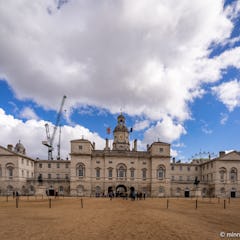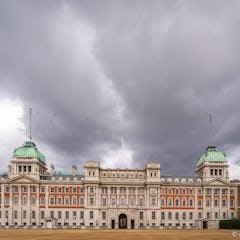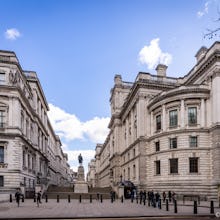In the very heart of London, between Whitehall and the greenery of St James’s Park, lies one of Britain’s most famous parade grounds. Horse Guards Parade is a place where uniforms, horses and perfectly rehearsed movements create a striking spectacle. It serves as a symbolic gateway between government buildings and royal ceremonies, with traditions that date back centuries.
At the gates, mounted guards in full uniform stand watch, attracting crowds of visitors keen to take a photo with a soldier and his horse.
History – From Tudor Jousts to Royal Parades
The history of Horse Guards Parade stretches back to the 16th century, when tournaments and court entertainments were held behind Whitehall Palace. During the Tudor era, the field was a centre of royal leisure, where courtiers gathered to watch elaborate spectacles.
When Whitehall Palace was destroyed by fire in 1698, the open ground remained and its role as a military training and assembly space grew. In the mid-18th century, architect William Kent designed the Horse Guards building, completed in 1755. Serving as a headquarters and barracks for the guards, it remains a defining landmark of the parade ground.
Over the centuries the field has hosted military gatherings and ceremonies. During the Second World War it briefly became a car park, but its ceremonial status was restored afterwards. Today it is once again one of London’s most important ceremonial spaces.
Architecture and the Horse Guards Building
Designed by William Kent, the Horse Guards building showcases 18th-century English Baroque with classical influences. Its imposing towers and clock dominate the façade, while the central archway connects Whitehall to St James’s Park.
Inside the building is the Household Cavalry Museum, where visitors can explore uniforms, equipment and the centuries of tradition that define Britain’s mounted guard.
Ceremonies – A Living Tradition
Horse Guards Parade is best known for its daily and annual ceremonies. The Changing of the King’s Life Guard takes place at 11 am on weekdays and 10 am on Sundays, lasting around half an hour. With gleaming uniforms, proud horses and precise manoeuvres, it is one of the most photographed spectacles in London.
In June, Horse Guards Parade hosts Trooping the Colour, one of the city’s largest annual events. More than 1,400 soldiers, 200 horses and 400 musicians take part in this spectacular celebration of the monarch’s official birthday. The parade often culminates in a Royal Air Force flypast painting the sky in the colours of the Union Jack. Tickets are highly sought after and must be booked well in advance.
Soldiers and Uniforms
The guards of the Household Cavalry are instantly recognisable by their ceremonial dress. The Life Guards wear red tunics with white plumes, while the Blues and Royals are known for their dark blue tunics and red plumes. Their polished helmets and meticulously maintained uniforms have changed little since the 18th century.
Household Cavalry Museum
Located within the Horse Guards building, the Household Cavalry Museum offers an in-depth look at the history and role of the mounted regiments. Displays include uniforms, weapons and ceremonial traditions, as well as the Cavalry’s combat role through the centuries.
A highlight is the glass viewing wall, allowing visitors to watch troopers at work: saddling horses, cleaning kit and preparing for daily duties. The museum appeals to all ages, with younger visitors especially captivated by the chance to see real equipment up close.
Location and Surroundings
Horse Guards Parade occupies a unique setting where political and royal London meet. Along Whitehall are government offices including 10 Downing Street, while on the other side lies the lush expanse of St James’s Park. From the parade ground you can enjoy views of the Horse Guards buildings, with the London Eye visible in the distance.
Within a short walk are The Mall and Buckingham Palace, as well as Westminster landmarks such as the Houses of Parliament, Big Ben and Trafalgar Square, making it easy to include Horse Guards Parade in a walking tour of central London.
Visitor Tips
Horse Guards Parade is an open public space, so you can visit at any time. For the most memorable experience, time your visit with the Changing of the Guard ceremony in the morning. The best viewing spots are taken quickly, so arrive early.
At the Whitehall entrance, two mounted troopers stand guard, always drawing crowds of photographers. The horses are well trained, but visitors should respect the guards’ and the horses space when taking photos.
The Household Cavalry Museum is open daily except major holidays, with admission including access to exhibitions and the working stables. Allow about an hour for the visit.
The parade ground is easily reached from several Underground stations, with Westminster, Charing Cross and St James’s Park all just a short walk away.






